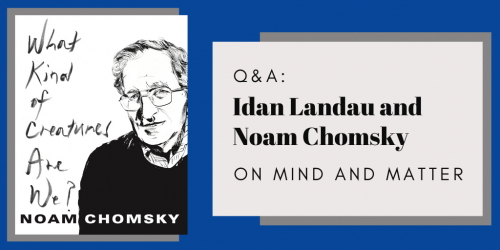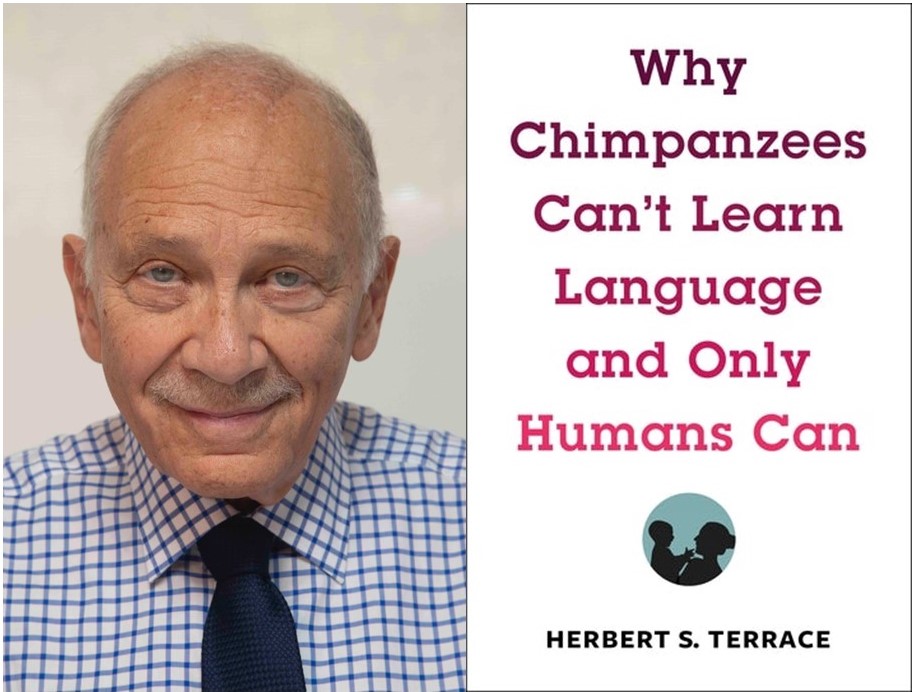Q&A: Idan Landau and Noam Chomsky on Language Design

“It’s always spring in Mr. Chomsky’s garden. Like John Ashbery, Noam Chomsky seems to come up with thoughts that are always fresh, unaffected by the polluting clichés that most of us inhale and exhale all day and night. To read his sentences is a life-giving elixir.”
~Wallace Shawn, author, Essays
The interview between Noam Chomsky, author of What Kind of Creatures Are We?, and Idan Landau, professor of linguistics at Ben Gurion University, Israel, continues today with a discussion about language design. Come back tomorrow for Chomsky’s take on skepticism.
• • • • • •
Idan Landau: A recurrent theme in your writings, and also in this book, is that “fundamental properties of language design” indicate that it is essentially an instrument of thought—not of communication. How then should we think of features of this design whose sole purpose seem to be communicative? First and foremost—topic-focus articulation, theme-rheme or presupposition-assertion, all variations on the same idea. These concepts presuppose a communicative situation where shared assumptions should be distinguished from unshared ones by some grammatical means; they are universal, in the sense that any language has some grammatical means of marking the distinction (by displacement, prosody, or morphology). Yet I can’t think of a way of rationalizing them from a strictly private point of view. One also wonders about evidential markers in many languages, which indicate the level of certainty or source of information for one’s utterance—again, a puzzling feature if language design ignores communication. Now, I know you distinguish between “design” and “use,” but that distinction isn’t self-evident, and we need criteria to tell why the mechanisms underlying these grammatical phenomena (and others, like factivity, indexicality, etc.) fall under “use” rather than “design.”
Noam Chomsky: These are interesting questions, which have never been carefully discussed. A simple answer comes to mind, but it may be worth looking into it more fully.
The simple answer derives from comparing Merge with the set S of examples of the kind you mention. Merge is the optimal combinatorial operation and the basis for what I’ve been calling “language design”—along with general (“third factor) principles of computational efficiency, which come free. Remove Merge from language and there’s nothing left. Remove S from language and nothing changes—some options aren’t used, which happens all the time. The qualitative difference is vast, justifying the conclusion that language is designed as a Merge-based system fundamentally—and it follows, as discussed in WKC, as a system of thought, with communication one of its uses.
But let’s look at the issues more carefully. I think we can approach them along the following lines.
“Language design” is a loose descriptive term. None of us believes that languages are designed. Nonetheless, I think we can make a useful distinction between fundamental principles of language (language design) and properties that languages happen to have, some universally. A principled way to approach this question is to begin by considering the goals of linguistic theory in the first place.
The goals of any theory are to find genuine explanations for significant properties of the domain under investigation. For language, that means genuine explanations for significant universal properties of language. A genuine explanation, at least within the biolinguistics program assumed in WKC and earlier work, has to satisfy the conditions of learnability and evolvability. The former has been a guiding concern since the beginning of the “generative enterprise,” hence the focus on poverty of stimulus, understood from the earliest days to be a serious problem and now known to be far more severe than had been supposed thanks to Charles Yang’s statistical studies of sparsity of data and extensive research into what is known by very young children. The latter has been put on the shelf until recently but is now I think within the range of discussion for reasons noted in WKC.
Genuine explanation within the theory of language is closely related to the Strong Minimalist Thesis (SMT), which proposes that the properties of language are determined by the optimal computational operation (Merge) and “third factor” principles such as minimal computation, principles that hold independently of language and in the best case might be considered natural laws. To the extent that SMT can be approached, we have genuine explanations (with evolvable innateness, hence learnability).
We can take core language design to be what receives genuine explanation, satisfying SMT. The concept can be extended by degree to more limited kinds of explanation. There is no need to draw a sharp boundary for a useful descriptive term like general language design unless some theoretical reason arises to do so. Let’s keep here to core language design.
The central part of WKC, from my perspective, is chapter 1, which reviews recent results that qualify as genuine explanations. To me at least, these seem to be results of real significance, new in the study of language and cognitive systems generally; in fact, hardly even formulable until fairly recently. Optimal computation (including choice of Merge as the core combinatorial operation) provides a basic account for the general architecture of language, what is sometimes called the “Basic Property” of language: narrow syntax generates representations at the conceptual-intentional (C-I) interface interpreted as thoughts, with externalization an ancillary phenomenon mapping syntactic structures to the sensory-motor interface, typically sound.
In addition to the basic property, the same elementary assumptions, as discussed in chap. 1, provide genuine explanations for other fundamental features of language: the ubiquitous property of displacement (IM), always previously regarded—by me in particular—as an anomalous “imperfection” of language but now shown to be the simplest case, which would have to be barred by stipulation; reconstruction and its intricate semantic consequences; the strange property of structure-dependence, implying that children reflexively ignore 100 percent of what they hear (linear order) and attend only to what they never hear and that their minds construct (abstract structure).
There’s more that I didn’t go into, for example, an explanation for why the more complex operation external merge (EM) is used at all; the conditions under which IM may, must, and does not apply; the locus of diversity and mutability of language in externalization; the status of parameters and feasible search spaces; and considerably more to a greater or lesser degree.
One consequence of these results is strong support for the traditional view that language design is a system of thought, and with externalization understood as an ancillary process, the use of language for communication, which depends on externalization, is still more peripheral to language design.
None of this should be very surprising. On the contrary, it should be expected. What is surprising is that such ideas took so long to resurface in the modern period and that they now seem surprising (if not downright offensive or virtually incomprehensible, as reactions often indicate). Externalization, after all, involves an amalgam of two systems, unrelated in evolutionary history and with quite different properties: language proper and sensory-motor systems, usually speech. For that reason externalization is not strictly speaking part of language alone. Nor should it be surprising that the locus of variation, complexity, and mutability of language turns out to be mostly, maybe entirely, in this amalgam.
Such expectations receive empirical support from the results concerning language design. And still further support from investigation of conflicts between communicative and computational efficiency (the latter a “third factor” property, hence conforming to SMT). In all known cases communicative efficiency is sacrificed. There is also neurolinguistic and psycholinguistic support, discussed in chap. 1.
There is no doubt that language is used for communication, though statistically speaking, as noted in WKC, it is rare, for whatever that is worth. There is nothing in the above analysis that excludes the possibility that some elements of language will be useful primarily for communication, but we would not expect them to be part of core language design. For example, imperative expressions are used primarily in socially interactive contexts, but while language design allows for them, they play no role in genuine explanation. I think that is true of the kinds of examples you raise generally, the set S. Language design provides options for these (and in some cases, like theme-rheme, may even provide partial explanation). But they do not have genuine explanations and do not participate in such explanations. And as noted, if they are dropped from language, nothing changes, just as nothing changes if languages were to drop color words.
It seems to me that the items of S can also be used in “internal dialogue,” the bulk of language use, and in this respect for thought, though their natural place, as you say, is social interaction, communication in some broad sense.
I don’t see then that they pose a dilemma
We might take note of the widely held doctrine that the function of language is communication and that language evolved from animal communication systems. The latter is an empirical hypothesis lacking support and facing strong counter-evidence. The former assertion has little substance, for reasons discussed in WKC. There would also be little if any substance to the counter-claim that the function of language is thought, unless interpreted as a way of saying that language design is a system of thought. That formulation is substantive and seems to me by now well grounded and of no slight significance.
These reflections bring up an intriguing issue that I avoided. True, externalization involves an amalgam of two distinct systems: language proper and sensory-motor systems. But isn’t that also true of narrow syntax, generating representations of thought, an external system? Or is it truly an external system? That question raises serious and rather obscure issues.
The traditional view was that language and thought are intimately related: for Wilhelm von Humboldt, they are literally identical; for William Dwight Whitney, language is “audible signs of thought”; for Otto Jespersen, arguably the last figure in the tradition that was swept aside in structuralist/behaviorist currents, unearthing “the great principles underlying the grammars of all languages” will yield “a deeper insight into the innermost nature of human language and of human thought” (quoted in WKC).
We have no clear concept of thought apart from linguistically constituted thought. That is why Alan Turing, in his famous paper on machine intelligence that initiated the field of artificial intelligence, wrote that the question of whether machines can think is “too meaningless to deserve discussion.” The C-I interface constitutes the external system to a certain extent (for Humboldt, completely). That is not true of the sensory-motor interface, which is entirely independent of language, another crucial asymmetry.
I am skipping over a lot of material (in particular, the parts of general syntax that are called “formal semantics,” a large topic). And there is, of course, a good bit more to say about these topics, but this should be enough to deal with the issues that arise here.






